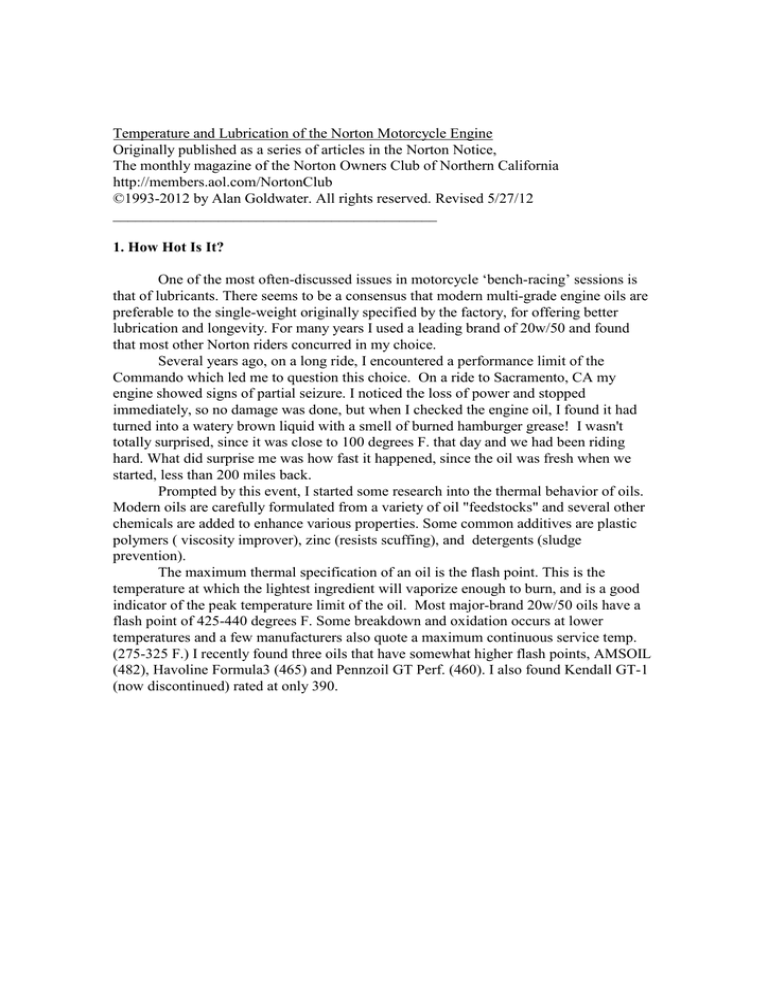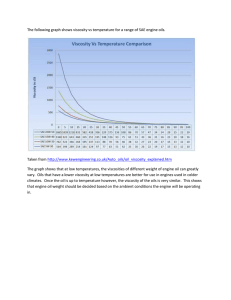
Temperature and Lubrication of the Norton Motorcycle Engine
Originally published as a series of articles in the Norton Notice,
The monthly magazine of the Norton Owners Club of Northern California
http://members.aol.com/NortonClub
©1993-2012 by Alan Goldwater. All rights reserved. Revised 5/27/12
___________________________________________
1. How Hot Is It?
One of the most often-discussed issues in motorcycle ‘bench-racing’ sessions is
that of lubricants. There seems to be a consensus that modern multi-grade engine oils are
preferable to the single-weight originally specified by the factory, for offering better
lubrication and longevity. For many years I used a leading brand of 20w/50 and found
that most other Norton riders concurred in my choice.
Several years ago, on a long ride, I encountered a performance limit of the
Commando which led me to question this choice. On a ride to Sacramento, CA my
engine showed signs of partial seizure. I noticed the loss of power and stopped
immediately, so no damage was done, but when I checked the engine oil, I found it had
turned into a watery brown liquid with a smell of burned hamburger grease! I wasn't
totally surprised, since it was close to 100 degrees F. that day and we had been riding
hard. What did surprise me was how fast it happened, since the oil was fresh when we
started, less than 200 miles back.
Prompted by this event, I started some research into the thermal behavior of oils.
Modern oils are carefully formulated from a variety of oil "feedstocks" and several other
chemicals are added to enhance various properties. Some common additives are plastic
polymers ( viscosity improver), zinc (resists scuffing), and detergents (sludge
prevention).
The maximum thermal specification of an oil is the flash point. This is the
temperature at which the lightest ingredient will vaporize enough to burn, and is a good
indicator of the peak temperature limit of the oil. Most major-brand 20w/50 oils have a
flash point of 425-440 degrees F. Some breakdown and oxidation occurs at lower
temperatures and a few manufacturers also quote a maximum continuous service temp.
(275-325 F.) I recently found three oils that have somewhat higher flash points, AMSOIL
(482), Havoline Formula3 (465) and Pennzoil GT Perf. (460). I also found Kendall GT-1
(now discontinued) rated at only 390.
Temperature and Lubrication of the Norton Motorcycle Engine
Originally published as a series of articles in the Norton Notice,
The monthly magazine of the Norton Owners Club of Northern California
http://members.aol.com/NortonClub
©1993-2000 by Alan Goldwater. All rights reserved.
page 2
Next I researched the thermal behavior of the motorcycle. I used several
thermocouples to measure temperature at various spots around the engine and oil tank.
For a test track I chose a road that has a flat straight section ten miles long, with easy
turn-around at both ends. It also offers steady, high ambient temperature and little wind.
Test runs of 10 miles were found to be enough for engine temperatures to stabilize at
various steady speeds. Oil temp required 20 miles to stabilize.
Here are some typical temperatures (Fahrenheit) at a steady highway speed of 65 mph in 90-degree still air:
cylinder head - 275
cylinder base 230
cam cover 210
engine oil intake 190
At a steady 75 mph these temperatures were all about 10 degrees higher.
During the testing I noticed an interesting effect. At the end of each test as I exited the
divided highway and slowed to a stop, the cylinder head temp shot up to around 325 and
as I idled the motor it continued to rise. It would stay over 300 up to around 40 mph, and
would gradually drop as speed increased. The oil temperature also rose, but much more
slowly. An extended period of idling (10 minutes) produced a maximum of 375 degrees
at the right rear head bolt, and nearly 400 degrees at the spark plug! This points out the
extreme sensitivity of head temp to air flow over the fins.
Then I tried an oil cooler. I cut a hole in the fiberglass side cover to allow an aluminum
extrusion heat sink to project through, retained by the cover. Contact between the heat
sink and the tank surface was enhanced with liberal amounts of white heat sink grease. At
road speed it typically lowered oil temp in the tank 10-12 degrees, but depended on wind
speed and direction more than I expected. You can see details of the cooler at
http://inoanorton.com/docs/cool-tec.pdf
To summarize my initial conclusions:
•
•
•
•
The Norton Commando is capable under extreme riding conditions of experiencing
engine temperatures that can cause rapid breakdown of commonly used oils.
The only place on the engine where such extreme temperatures can occur is the
cylinder head.
The condition most likely to create oil-destroying temperature is reduced airflow over
the cylinder head, especially following or combined with high-speed or uphill riding.
All oils are not equal and some differ greatly from the norm in their maximum
temperature rating.
Things To Avoid:
Drafting behind trucks
Riding hard with tailwind
Being stuck in traffic
Temperature and Lubrication of the Norton Motorcycle Engine
Originally published as a series of articles in the Norton Notice,
The monthly magazine of the Norton Owners Club of Northern California
http://members.aol.com/NortonClub
©1993-2000 by Alan Goldwater. All rights reserved.
page 3
2. How Hot Is Too Hot?
In the previous chapter I discussed the limiting factor of oil flash point. I found
that popular multigrade oils varied widely in their maximum temperature, including the
so-called synthetic oils. I have now found one reason for this and I am indebted to Lou
Caputo for passing on the following data, published by Red Line Oils of Martinez.
There are four basic kinds of feed stock used in lubricating oils today. Petroleumbased oils are most common and typically boil (flash) at around 400-420 degrees F. Oils
made from chemicals called poly-olefins are basically synthetic petroleum and boil at
slightly higher point due to their purity, say 440-450. Mobil1 and Castrol Syntec
synthetics are this type. Another basic variety, diester oils, are made from organic fatty
acids and alcohol, and boil at around 470 F. Amsoil and perhaps Havoline Formula 3 are
representative of this type.
Both the diesters and poly-olefins cost several times as much as the petroleumbased oils, but are supposed to last around 4 times as long while offering superior
lubrication. Diester-based oils are thought to have some degrading effect on rubber parts
such as seals and oil filter components, but I have heard no first-hand reports of
problems.
A final type of oil base is pentl polyol ester. This is a more complex version of the
diester base and boils at over 520 F! To my knowledge only Red Line uses this
expensive feed stock. In particular, their racing oil is pure polyol ester, which they claim
has the extraordinary film strength of 500,000 psi, great for those soft Norton camshafts.
3. Keep It Cool
Earlier I reported that the highest engine and oil temperatures occur at relatively
slow air speeds (ie. around town or with a tailwind). My next test cycle with an oil cooler
installed on the bike showed it to consistently reduce oil temperature in the tank by
around 12-15 degrees. Next, I inserted a thermocouple through a small hole in the exhaust
valve cover to measure the temperature of the oil flowing down the pushrod tunnel inside
the head. I found that at speed the oil temperature inside the head is about 35 degrees
cooler than the head itself, measured at the side head bolts. This is important because it
shows that there is enough oil flow to actually cool the head, provided that the oil enters
the head at a low enough temperature. On repeating my original tests, I found that the oil
cooler also reduced the cylinder head temperature by about 10-12 degrees. At 65 mph, oil
temp in the pushrod tunnel was 241 F, dropping to 228 with the cooler installed. Cylinder
head temp dropped from 275 to 263.
To summarizemy conclusions, an oil cooler can reduce the risk of premature oil
failure, but not enough to guarantee lubrication under the harshest of real-world riding
conditions. Choice of lubricant also has potential to extend the safe service life under
such conditions, and will be investigated next.
Temperature and Lubrication of the Norton Motorcycle Engine
Originally published as a series of articles in the Norton Notice,
The monthly magazine of the Norton Owners Club of Northern California
http://members.aol.com/NortonClub
©1993-2000 by Alan Goldwater. All rights reserved.
page 4
4. And The Winner Is…
In an extended testing program, I evaluated the service life of three synthetic oils,
which have respective flash points of about 410, 440, and 520 F. Over three successive
riding seasons, I rode at least 1000 miles using each of these oils, including a 400 mile
August ride in high temperature, moderate speed conditions. After 1000 miles, I sent a
sample of each oil to Herguth Laboratories in Vallejo, CA for OilScan Analysis. Here are
the results of my testing:
Test Sample
Oil type and miles
Golden Spectro 20w/50 1k mi
Mobil 1 15w/50
1k mi
Red Line 20w/50
1k mi
Red Line 20w/50
3k mi
ppm.
Iron
25
17
20
33
ppm.
Alum.
19
14
11
17
ppm.
Copper
175
12
42
56
ppm.
boron
134
154
20
23
%
oxidation
100
33
2
37
The metals content in parts per million (ppm) shows wear for different parts of the
motor. Iron and aluminum are from the cylinder and piston respectively, both within
normal limits. Copper is from the rod bearings or cam bushes, and boron may be an
additive or a rod bearing constituent. The most interesting number is that for oxidation, as
it directly measures the percentage of the oil molecules that have been broken apart by
overheating. As you can see, the Golden Spectro was used up at 1000 miles and the
Mobil 1 was well on its way. With only 2% oxidation the Red Line was essentially
unchanged by the test miles.
I called Spectro and Mobil, and both confirmed that they use Boron as an antifriction additive. Spectro could offer no explanation for the high oxidation measurement.
They asked for a sample, which I sent them but I never heard back. One chemist I talked
to suggested that Golden Spectro is a blended (i.e. part synthetic) oil which uses a styrene
viscosity enhancer. According to my Chemical Handbook styrene is a colorless liquid that
boils at 295 F so this is a good candidate for trouble. Some of the styrene derivatives like
beta-phenylethylene boil as high as 392 F but none are over 400 F. The high copper
indicates accelerated bushing or rod bearing wear which is certainly not desirable.
My final test was an extended period of 3 thousand miles using Red Line 20w/50
synthetic. While the oil (and bike) survived, the oxidation at 37% is higher than I would
like, although its nearly equal to that of Mobil 1 at a thousand miles. Based on these
results, I recommend a harsh-conditions service life of 2k miles using Red Line, or 1k
miles with Mobil 1. I would not recommend the use of any other oil under such
conditions.

